lukaswelker wrote:
What is the probability that a student randomly selected from a class of 60 students will be a male who has brown hair?
1. one-half of the students have brown hair.
2. one-third of the students are males
We can also use the Double Matrix Method to visually represent the information for this question. This technique can be used for most questions featuring a population in which each member has two characteristics associated with it.
Here, we have a population of students, and the two characteristics are:
- male or female
- has brown hair or doesn't have brown hair.
There are 60 students altogether, so we can set up our diagram as follows:
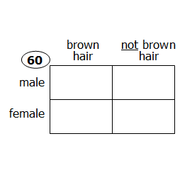 Target question: What is the probability that a student randomly selected from a class of 60 students will be a male who has brown hair?
Target question: What is the probability that a student randomly selected from a class of 60 students will be a male who has brown hair?
So, we must determine how many of the 60 students are males with brown hair. Let's place a STAR in the box that represents this information:
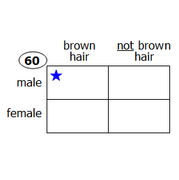 Statement 1: one-half of the students have brown hair.
Statement 1: one-half of the students have brown hair.
So, 30 of the students have brown hair, which means the remaining 30 students do NOT have brown hair.
When we add this information to our diagram, we get:
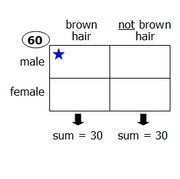
Do we now have enough information to determine the number in the starred box? No.
So, statement 1 is NOT SUFFICIENT
Statement 2: one-third of the students are males
So, 20 of the students are males, which means the remaining 40 students are NOT males.
When we add this information to our diagram, we get:
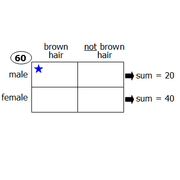
Do we now have enough information to determine the number in the starred box? No.
So, statement 2 is NOT SUFFICIENT
Statements 1 and 2 combined
Combining the information, we get:
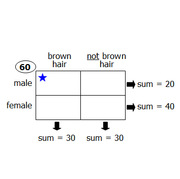
Do we now have enough information to determine the number in the starred box? No. Consider these two conflicting cases:
case a:
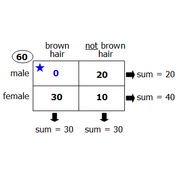
Here,
0 of the 60 students are males with brown hair, so
P(selected student is male with brown hair) = 0/60
case b:
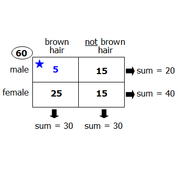
Here,
5 of the 60 students are males with brown hair, so
P(selected student is male with brown hair) = 5/60
Since we cannot answer the
target question with certainty, the combined statements are NOT SUFFICIENT
Answer =
E
-------------------------------------------
To learn more about the Double Matrix Method, watch our free video:
https://www.gmatprepnow.com/module/gmat- ... ems?id=919
Once you're familiar with this technique, you can attempt these additional practice questions:
Easy Problem Solving questions
-
https://www.beatthegmat.com/the-aam-aadm ... 72242.html
-
https://www.beatthegmat.com/finance-majo ... 67425.html
Medium Problem Solving questions
-
https://www.beatthegmat.com/probability- ... 73360.html
-
https://www.beatthegmat.com/posted-speed ... 72374.html
-
https://www.beatthegmat.com/motel-t271938.html
-
https://www.beatthegmat.com/of-the-appli ... 70255.html
-
https://www.beatthegmat.com/opening-nigh ... 64869.html
-
https://www.beatthegmat.com/ds-french-ja ... 22297.html
Difficult Problem Solving questions
-
https://www.beatthegmat.com/ratio-problem-t268339.html
-
https://www.beatthegmat.com/overlapping- ... 65223.html
-
https://www.beatthegmat.com/fractions-t264254.html
-
https://www.beatthegmat.com/overlapping- ... 64092.html
-
https://www.beatthegmat.com/mba/2011/05/ ... question-2
Easy Data Sufficiency questions
-
https://www.beatthegmat.com/for-what-per ... 70596.html
-
https://www.beatthegmat.com/ds-quest-t187706.html
Medium Data Sufficiency questions
-
https://www.beatthegmat.com/sets-matrix-ds-t271914.html
-
https://www.beatthegmat.com/each-of-peop ... 71375.html
-
https://www.beatthegmat.com/a-manufacturer-t270331.html
-
https://www.beatthegmat.com/in-costume-f ... 69355.html
-
https://www.beatthegmat.com/mba/2011/05/ ... question-1
Difficult Data Sufficiency questions
-
https://www.beatthegmat.com/double-set-m ... 71423.html
-
https://www.beatthegmat.com/sets-t269449.html
-
https://www.beatthegmat.com/mba/2011/05/ ... question-3
Cheers,
Brent




























